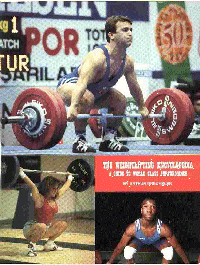
Two of the hottest prospects in the American weightlifting scene are Blair Lobrano (who broke all of his Junior American records and took fifth place at the 1994 Junior World Championships and placed second at the 1997 National Championships) and Buster Bourgeois (who broke all of his Junior American records and placed eighth in the same competition at the age of seventeen).They are members of the Gayle Hatch Weightlifting Club. Gayle Hatch has been active as a weightlifting and strength coach for twenty years. His club has won the team competition at many Junior National Championships in recent years, as well as three Senior National Championships. Gayle has also had at least one athlete on three out of the last four United States Olympic teams.
He has honed his approach to training over many years of day-to-day work with young athletes. He bases his approach on the classic periodization model, with preparatory and competitive periods and mesocycles that are four weeks in length whenever possible. During each mesocycle there will typically be three weeks of heavy loading followed by one unloading week.
Six weeks before the 1994 Junior World Championships, Gayle shifted his mesocycle to three weeks in length, with two weeks of heavy loading followed by an unloading week. During the course of the year preceding the Junior World Championships, Blair Lobrano lifted a total of 21,000 reps with weights that were 75% of his maximum or more. Fifty-five percent of Blair's reps were in the 75% to 85% range, 40% were in the 90% to 95% range and the remaining 5% were in excess of 95% (more recently 55% of the reps have been in the 75-87.5% range and 40% have been in the 87.5%-95% range).
Buster Bourgeois' training was similar to Blair's, except that Buster's total number of repetitions during the year was significantly lower. The reason for this is that Buster was playing football during this period. For the twelve weeks of the football season, Buster reduces his training to two to three sessions a week. This enables him to maintain his conditioning both for football and weightlifting during the season.
Gayle's lifters perform segment work in the classic lifts. However, while they perform many singles, they do many doubles and triples as well. (Gayle feels that these reps are key factors in of strength development.) During the preparatory period, Gayle's lifters do a significant number of squats and pulls in sets of five repetitions.
Blair and Buster (when the latter was not playing football) trained nine times a week (six days, with two of those days having two workouts). They used a wide variety of exercises, including: the classic lifts, power snatches, cleans and jerks, overhead, front and back squats, snatch and clean pulls, jerks from the rack, push presses, jerk lockouts and recoveries, jerk drives, presses, Romanian deadlifts, step ups, single leg squats, hyperextensions, good mornings, abdominal work and jumps.
When Gayle's athletes move from the junior to the senior ranks, he believes in reducing the number of exercises they perform and focusing their training efforts more on the classic lifts and related exercises. There is a reduction of approximately 1000 reps in annual volume as a consequence of this change.
Gayle also believes in careful supervision of his charges. He observes virtually every workout, carefully adjusting the planned load for the condition of the lifters on that day.
While there is no doubt that the training programs that Gayle uses are effective, as an outsider looking in, I would have to say that much of the success that Gayle and his athletes have enjoyed stems from the attention that he devotes to the mental aspects of the sport. He inculcates a team spirit in his charges. His gym is steeped in symbols of his team's success. Gayle has had banners made to represent each of the approximately 40 national level championships (AAU Junior Olympic through Sr. National) which his teams have won. An athlete raised in such an environment cannot help but be awed by the tradition that he or she is joining. But Gayle does not overlook the importance of individual achievement. A variety of boards record the personal records and rankings of individual athletes. Who would not be motivated by the opportunity to change the numbers next to his or her name?
As is so often the case, the contributions that a great coach makes often extend beyond the reach of the athletes whom he or she helps directly. Denis Snethen, coach of the Wesley Weightlifters, the 1995 Men's Senior National Champions, says that he has patterned much of what he has done with his club after Gayle Hatch's program. What greater honor could there be than to be beaten by a team you inspired? Despite the honor, no doubt Gayle will be working to see that he is not "honored" by Denis' team too often in the future.
The preceding was an excerpt from The Weightlifting Encyclopedia: A Guide to World-Class Performance by Arthur Drechsler. This book is the most comprehensive and authoritative reference ever written on the sport of weightlifting. For more information on this extraordinary book, click on the cover below.